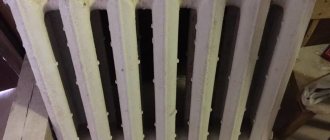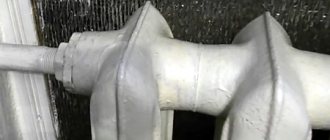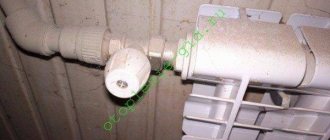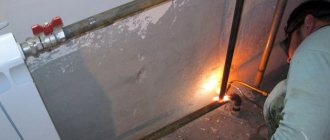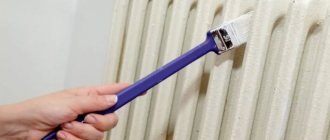Over time, old batteries lose their aesthetic appearance, rust appears, cracks appear in the coating, and paint peels off. Agree, changing the radiator in this case is not the best idea. It is much easier, faster and more economical to repaint the battery. Moreover, it is quite easy to update the appearance of the heating device.
We will help you choose the appropriate enamel composition, explain how to prepare and how to paint the heating radiator correctly. We will also outline the nuances that should be taken into account when working with different types of radiators.
The proposed photo ideas will inspire you to choose an interesting solution and implement your design idea.
Which batteries can be painted and which ones shouldn’t?
Before considering the variety of paints, let's talk about whether all types of radiators are recommended to be painted. So, first, decide on the type of your heating battery, because this determines whether it can be painted, or whether it is better to abandon this idea:
- It is not advisable to paint modern aluminum and bimetallic batteries. Initially, they are painted at the factory with durable powder paint, which, thanks to the peculiarities of the technology, lies perfectly evenly. If you decide that the original color of the radiator (usually white) does not suit the interior of the room, and you want to repaint it, then you are unlikely to be able to achieve the same perfectly even coating. Even if you remove the battery and paint it horizontally. In addition, an additional layer of paint will reduce heat transfer, which is a significant disadvantage for regions with harsh winters.
- It is not advisable to paint plate radiators, especially those with a large surface area. They are installed in houses where there is a network with increased internal pressure. They have low convection but high heat transfer. As for our question, due to its design, it is difficult to properly paint a heating radiator of this type, especially with a brush. If this is really necessary, then you will have to remove it, clean it thoroughly (which is very difficult) and paint it in a horizontal position with a spray gun or car paint in the form of a spray. But even this way you may not achieve a perfect application. There may be missing areas in hard-to-reach places, because the elements of the plate radiator are located too close to each other.
Important! Manufacturers recommend painting only the removable metal linings, and only cleaning the rest of the dirt and dust.
- Convectors and pipes with fins (especially with frequent aluminum fins) are not painted, since painting can negatively affect their heat transfer. The design of the convector, in addition to the heat source, includes a removable casing. It can be painted to enhance the overall look.
- It is recommended to paint cast iron batteries. This is not difficult to do, different paints are suitable and they do not affect the heat transfer. The choice of colors is huge.
- It is possible to paint steel panel radiators. But there is a nuance here - you won’t be able to evenly cover the surface of the battery with a brush. You will have to use car paint in a can, and it is advisable to paint in a horizontal position.
Preparing to paint the radiator
To do this, the following three states of the heating radiator can be taken into account:
- The old paint layer does not have any cracks or chips. This means that the previous one was completed as correctly as possible, so in this case you can proceed directly to applying a fresh coating.
- If the surface of the battery has small areas with chipped and peeling paint, this means that these areas require sanding to obtain a smooth surface, and only then painting.
- Provided that the old coating has come off almost completely, painting radiators can only be done with serious preparatory work, which will require the use of a brush equipped with iron bristles, or a special washing solution with the addition of a certain amount of alkali.
Mechanical cleaning of heating devices
Mechanical removal of old coating involves the use of a wire brush. Using this tool you need to clean the surface before painting the radiators. To facilitate the process of cleaning the battery and achieve maximum efficiency, you can take a grinder and special attachments for it. This could be a cleaning wheel or a brush.
Power tools help remove old coating in a fairly short period of time. However, working with a drill requires careful handling; cleaning should not be done at high speeds, as this may damage the surface of the radiator. This applies in particular to cleaning heating appliances made of non-ferrous metal. In this case, you can only clean areas with cracked or chipped paint.
Types of dyes for batteries
Many types of paints, or rather individual representatives of these types, meet the above requirements. After all, most paints are designed for temperatures below +80 °C. Therefore, manufacturers produce special modifications of their products.
In general, painting batteries yourself can be done with the following types of paints:
- Acrylic enamels. They are based primarily on organic solvents. This feature causes the release of a solvent odor during the application of the acrylic mixture to the battery. However, once it dries, the smell becomes history and the room is left with a radiator with a nice glossy shine. This shine lasts for many years.
- Alkyd enamels. They are known for their excellent resistance to wear and high temperatures. The range of colors of these enamels is very large, so many people choose such paints. These paint solutions also emit an unpleasant odor as they dry. It can also be felt in cases where the heating radiator gets very hot.
- Water-dispersion paint. Many experts note that such paint for radiators is optimal. This is because it does not upset the nose with a specific smell, and the drying time is very short. True, not every water-based mixture is suitable for batteries. Only those that have the appropriate designation on the packaging are suitable. Its color can be any.
- Oil paints. They were very popular in the past. Known for emitting a solvent odor upon drying and long curing times.
It is worth adding that radiator paint may contain elements that resist corrosion and improve adhesion (they are constantly used in primers). Such mixtures have different colors and do not require primers or cleaning the radiator from corrosion.
At least that's what the manufacturers note. In practice, it is better to remove rust from the heating device and use a primer. The processes are lengthy, but the results are reliable. This is often noted in various videos.
Painting the battery throughout the heating season
Anyone who has painted heating radiators knows that it is not easy.
Preparation
The first step is removing the old paint. Due to the fact that the design of the battery makes many of its places difficult to reach, it is not possible to clean it the old-fashioned way using a metal brush.
A soldering iron or hot air gun will not work. Since in the first case the structure can be damaged, and in the second it is simply useless.
Paint remover can remove paint even in hard-to-reach places
Of course, this method also has its drawbacks, but it still gives the best results. The remover works on the principle of a solvent. It penetrates the paint layer, softens it and then scrapes off the old paint quite easily with a putty knife or metal scraper.
Among other things, the remover does not damage metal or wood, so it can be used before batteries
.
Beautiful batteries will decorate the kitchen
How to paint batteries:
The process of painting radiators
- apply wash;
- remove old paint;
- rust must be sanded off;
- treat the battery with a degreaser (white spirit or slightly alkaline solution);
- if necessary, apply a primer;
- After drying, you can apply the main color.
Think of your own interesting radiator decor
- Batteries should only be painted when they are cold
. Therefore, it is better to postpone all work to a time when the heating season has already ended. If the need arises in the autumn-winter season, turn off the valves and wait until it cools completely. - If you have to apply paint to warm radiators, use a spray can or apply a very thin layer
. The whole difficulty of applying paint to a hot surface is that brush marks remain. In addition, if the paint is changed, the batteries will become stained. - Radiators can only be connected after the paint has completely dried.
.
Interesting colored batteries will become a highlight of the kitchen
How to choose the right paint for heating radiators:
Questions and answers
Is it possible to add color to the paint if you are not satisfied with the originally acquired shade?
It is possible, but the color must match the characteristics of the type of paint.
Is it possible to paint heating pipes?
Yes, but also not with ordinary paint, but with special heat-resistant paint.
Is it necessary to turn off the heating when painting?
On hot surfaces, the unpleasant odor of some paints noticeably intensifies. Therefore, it is better not to carry out such repair work during the heating season.
Do I have to remove the batteries when spray painting a wall?
It is not necessary to remove it, but it is advisable. Because spraying will damage the appearance of the adjacent wall.
Why can't you use regular everyday paint?
Batteries constantly heat up and cool down, which weakens the paint.
Paints come in different colors
Painting of radiators and pipes begins with the selection of substances with which to paint the metal. If the photo shows an amazingly beautiful painting of radiators, this does not mean at all that the artist managed to achieve this effect after the first layer of paint. Painting batteries is a rather complex process consisting of several stages. There are various means of painting heating radiators on the modern market. Before answering the question of how to paint a battery or studying the process of painting a battery captured on video, you need to figure out what kind of paint can be used to do all this. The easiest option for selecting paint is to purchase it at a special shopping center that sells radiators and heating pipes.
Paint for heating devices.
Specialist consultants will tell you what type of paint is suitable for painting the heating radiator. Cast iron radiators and other heating system elements are painted with abrasion-resistant paints. Batteries should only be painted with paints that are resistant to aggressive environments. In the video showing how to paint radiators, you rarely see the can of paint itself. And this is an important point for those who decide to paint the batteries themselves. Battery paint must be heat-resistant. The absence of toxicity of dyes is one of the most important points. The batteries heat up, and if the paint applied to them is toxic, this directly threatens the life and health of people in the building.
Acrylic
There are two types of paints for heating batteries. Acrylic enamels are based on organic solvents. If you paint heating radiators with them, you won’t have to worry about the appearance of the heating system for a long time, since acrylic enamels have the ability to retain their shine and aesthetic appearance for a long time. They are an attractive option for those who prefer a variety of colors when painting heating radiators. However, acrylic enamels have a significant drawback: an unpleasant odor that remains even after painting the radiators is finished. Moreover, when the radiators heat up, the unpleasant odor returns and causes discomfort.
Spray paint.
Water-dispersed
When deciding what to paint radiators with, experts usually recommend water-dispersed paints. They do not have a specific smell. Heating radiators painted with them look aesthetically pleasing. Water-dispersed paints have a wide range of colors. If you don’t know what to paint batteries with, it’s better to choose them right away
In order not to make a mistake when purchasing, you need to pay attention to the cans in which the paint is sold. They must have special markings indicating that the paint is suitable for painting heating radiators and pipelines
It is possible to paint radiators with oil paint, but it is practically not used for these purposes.
Varieties of compositions for coloring batteries
When painting a battery, first of all you need to pay attention to the technical component of the dye. But aesthetic characteristics also play an important role.
Advantages of acrylic dyes
Acrylic paints, which belong to the group of water-based dyes, allow you to kill two birds with one stone. Their undoubted advantage is that they do not emit harmful substances, are odorless, and are safe for humans.
They dry quickly (about 30 minutes at a temperature of 18-23 degrees), have water-repellent properties, and form a very durable coating that is resistant to mechanical stress.
The technical and aesthetic characteristics of acrylic dyes are excellent for heating appliances
And, perhaps, the most important thing is that they can withstand high temperatures perfectly, maintaining their qualities and without changing their original appearance for seven to eight years.
During this time they will not turn yellow, crack or peel. The whiteness coefficient of acrylic dye is 96%, the color is very rich and bright, and the surface looks like a plastic coating with a slight shine.
Features of alkyd compositions
Alkyd paints have high heat resistance and are also suitable for painting batteries. They are superior in strength to acrylic compounds, have anti-corrosion properties, adhere well to the surface, forming an even and beautiful coating.
However, they are not as safe as water-based paints. The solvent included in their composition causes an unpleasant odor that remains in the room for at least a day.
Paints dry quite slowly, and a specific smell can persist even after drying. Alkyd dyes can only be used in a well-ventilated area, and it is advisable to leave it completely until the smell has completely evaporated.
When working with alkyd compounds, you must take precautions and thoroughly ventilate the room.
Another significant drawback is that paints retain their color for a relatively short time and begin to turn yellow over time. If you do decide to paint the battery with alkyd paint, it is better to choose a composition that forms a glossy finish.
In this case, the period during which the radiator will remain white increases by about 20%, compared to matte and semi-matte paints.
Other types of paint for heating devices
For painting heating radiators, paints based on aluminum and silicate resins are suitable, forming a dense and elastic layer on the surface on which cracks do not appear even with temperature changes.
Silicate paints are characterized by high adhesion and do not require preliminary priming of the surface; they are designed to work at very high temperatures. Their disadvantage is a strong unpleasant odor.
Another type of paint that is worth focusing on is hammer paint, which is a type of alkyd composition. They form a rather interesting, but very specific coating. After their application, the surface is not smooth, but as if beaten with a hammer (hence the name) or with a hammered effect.
Hammer paints perfectly hide all the unevenness of a cast iron radiator - a property that is very useful for home owners with an old heating system
A significant advantage of hammer dyes is that the non-uniform texture will make various roughnesses, irregularities and other minor defects of radiators invisible.
This property is especially valuable when it comes to painting old Soviet-era cast iron batteries, the rough surface of which will be completely hidden behind the original coating.
Very often, silver paint is used to paint radiators, which is a mixture of varnish and aluminum powder. It withstands high temperatures perfectly and can be applied both to the primer and to the old coating. However, the paint has a persistent odor, so the room must be well ventilated during and after its application.
Silver can be purchased ready for application. You can prepare the composition yourself by mixing two parts aluminum powder with five parts varnish
Aluminum powder is an explosive substance. The process of cooking yourself is quite risky. You should not resort to it if there are easily flammable structures in the house, and especially small children.
How to choose the right paint for radiators
A wide range of different brands leads to the fact that buyers are faced with the problem of which paint to choose.
Therefore, when choosing, you must pay attention to whether the enamel meets the following requirements:
- lie flat on metal products;
- Provide protection against rust and corrosion damage;
- Withstand elevated temperatures;
- Maintain the original color for a long time.
When choosing paint, it is important to consider the material from which the radiator is made.
In addition, it is also necessary to take into account what material the batteries and radiators are made of. After all, they can be made from a variety of metals, as well as their alloys. Experts recommend following several tips:
- For devices made of steel, aluminum and bimetallic composition, it is better to use acrylic or alkyd paints;
- Any type of enamels, except oil-based, are well suited for cast iron batteries. However, in order for the substance to lay down in an even and thin layer, it must be mixed with a thinner;
- It is better to refuse to use oil paints, even of the most famous brands, because they very rarely perform protective and decorative functions at the same level as others
Nuances and tips
To ensure that the paint on radiators does not crack or fall off in pieces, but creates coziness and comfort, we turn to the advice of specialists who know all the nuances of painting batteries.
- Modern central heating systems provide for regulating the air temperature in the apartment using special taps. Therefore, before starting work, you can “switch off” the radiator, and when the paint has dried, turn it on.
- There is no need to rush while painting. Otherwise there will be drips. To prevent this from happening, constant monitoring of already painted areas is needed. If necessary, the sagging is rubbed over the surface with a used brush.
- When choosing paint, you need to consider the purpose of the room. So, cheap materials are suitable for the office. For children's paint should be odorless. Here you can beautifully paint the batteries. One of the design options is shown in the photo below.
- The paint should be for batteries. Using standard paint materials designed for floors, walls and ceilings is not the best solution. In most cases, they crack and turn yellow when exposed to high temperatures.
- On the glossy surface, all paint imperfections, unevenness and other shortcomings of the heating radiators are clearly visible. Therefore, it is better to choose matte paint. But here, too, you need to take into account the fact that the matte finish should not be white - due to dirt in the pores of the metal, it quickly turns gray.
- It is becoming fashionable to choose paint colors for batteries that match the color of the walls.
- It is better not to paint radiators made of aluminum and stainless steel. They are painted in the factory using sophisticated technology. It is impossible to repeat it at home, and applying regular paint most likely will not work - it will run off due to lack of adhesion. If successful, it will not last long - it will fall behind completely or in pieces. The solution is to replace the batteries with new ones or install a decorative screen.
- Steel convectors can be painted, but after this the heat transfer drops sharply. Therefore, here too it is better to use a decorative screen.
Features of preparation
There are two ways to remove a layer of old paint:
The first involves using a spatula or round metal brush attached to an electric drill. Using a spatula requires physical effort as you need to move it with your hands. Moreover, it will take quite a long time to wash off the paint. This must be taken into account when calculating the total painting time. The disadvantage of this option is that it is difficult to reach the bottom of thin cracks.
A round metal brush attached to an electric drill is a more versatile method.
The chemical method involves the use of special solvents or fatty acids. They treat the entire area of the battery and cover the treated surface with film. Then they rest. The duration of rest is indicated on the packaging. It may be different. During this time the paint becomes soft. Of course, it does not slip (which would be very good), but its removal with a spatula, a grinder or a wire brush becomes very easy.
It is worth remembering that solvents emit substances harmful to the body. Therefore, when using a chemical method, you need to protect your hands with construction gloves, your respiratory tract with a gauze bandage, or even better, a respirator.
The surface of the radiator, cleared of paint, is treated with sandpaper. They work especially carefully in places where there is corrosion. It needs to be completely removed. Only a pure metallic sheen should remain.
For degreasing, use white spirit or any other alkaline solution.
The radiator is primed with a solution that meets the following requirements:
- is a product of the same manufacturer that produced the paint. In this case, the primer and paint work best together;
- contains substances that can resist corrosion.
Interesting Coloring Ideas
The white radiator is a classic that we have become accustomed to since Soviet times, when almost all houses were equipped with the same type of cast-iron radiators.
The color of the heating device, if it affects heat transfer, is only to a very small extent, so nothing prevents you from painting the radiator in accordance with the interior of the room.
The battery can be made almost invisible if you paint it the same color as the walls
Today you can find many interesting design solutions where the radiator is one of the decorating elements that harmoniously fits into the surrounding space.
On the contrary, you can build a composition using contrast, and make the battery an accent that attracts attention, painting it in a bright rich color.
The red battery against the background of a light interior looks unusual and very impressive
Today it is very fashionable to paint objects using the ombre technique. Its essence lies in the fact that the first sections of the battery are painted in pale, subtle shades, all subsequent ones are a tone or two darker, and for the last sections very bright saturated colors are used.
A battery painted using the ombre technique will be an excellent decoration for any interior.
The most creative design ideas can be implemented in a children's room.
You can decorate the radiator sections in different rich colors, paint the battery with interesting designs, turn it into a zebra or a set of colored pencils
Choosing the Ideal Battery Paint
It is important to determine which paint is best to transform radiators. There are a number of requirements that the paint applied to batteries must meet
Heat resistance of the paint is required at least one hundred degrees; abrasion resistance and non-toxicity are also required, since the batteries are regularly cleaned and the radiator itself heats up. The greatest heat resistance is achieved by paint containing metal powder instead of coloring pigments.
There are special paints for radiators on sale; many people use water-based enamels and heat-resistant varnishes. The paint you choose must be suitable for coating metal and match the primer. Good compounds are durable, do not change color, and can protect themselves from corrosion.
Glossy shine and long-term color fastness are ensured with acrylic enamels based on organic solvents. But they smell quite strong when applied.
Water-dispersed paints dry quickly, but it is important to select them carefully, choosing special types. After painting with alkyd enamels, the uniformity of the coating is guaranteed, it will be durable and resistant to influences
However, the smell can be observed not only during the painting process, but also some time after drying, released from heating.
Color selection
The decision on what color is best to paint the radiators is up to the owners. A wide range of products and various formulations are now available. White enamels and silver are considered classic. Some choose colors in accordance with the interior, lighting, general style of the apartment and design features. Gold and bronze shades, subtle patterns and designs look unusual.
If the look of your old radiators no longer pleases you, then you can try to breathe new life into them through experiments
- The quality of painting of cast iron batteries also largely depends on how well they are prepared. A smooth foam roller of small diameter is optimal as a tool for applying paint, and a brush is useful in hard-to-reach places. To decide for yourself how to paint most conveniently, you should think about removing the batteries. The radiator, separated from the pipes, can be coated with the composition on all sides, so there will be significantly fewer hard-to-reach places. However, this method does not always pay off; sometimes it is easier to paint the battery more thoroughly without wasting time on removing it. It all depends on the specific circumstances and the shape of the radiator.
- A very important factor is the temperature of the surface to be painted: the radiator must be cold. To the question “is it possible to paint hot batteries?” any specialist will answer unequivocally: this cannot be done. The most convenient moment is when there is no heating season. But the beginning of the heating period will not be a hindrance if you close the valves on the radiators, stopping the access to boiling water. It is enough to wait until they cool completely to start painting. If paint is applied to a hot radiator, it will lie unevenly, swell, and various stains and stains will probably form. Moreover, you can turn on the heating only when the paint is completely dry.
Painting radiators and heating pipes requires care and precision. It is good to use brushes, small rollers, and spray cans. It is optimal to use a spray gun to process the previously removed battery, then all hard-to-reach areas will be perfectly painted. It is from those places that are least accessible that you should start painting
It is important to maintain a uniform layer thickness, otherwise the color may further differ in different areas. It is recommended to start painting from the top, then accidental drips will not spoil the lower part. You need to cover the entire battery with the composition, not limited to its front part.
It is more effective to apply paint in two thin layers, and wait until the first one has completely dried before painting again. Then there will be no drips, and it’s easier to achieve perfect evenness with thin layers.
Is this acceptable?
During the warm season, owners of city apartments try to go to the sea, to the countryside, or to start construction. As a rule, the end of autumn and winter are left for redecorating rooms. At the same time, questions about whether it is possible to paint the ceiling, hang wallpaper or replace the finishing floor covering during the cold season do not usually arise.
But with central heating, not everything is so simple. Many people doubt whether it is possible to paint hot radiators and pipes. After all, paint dries quickly on a heated surface, which can result in minor defects in the form of sagging, stains, and a network of microcracks. In addition, it is difficult to get rid of the pungent odor inherent in some types of solvents - ventilation with open windows leads to significant heat loss.
Despite these possible problems, the answer to the question: is it possible to paint batteries in winter, is positive. With the right paint, good preparatory work and following the instructions for painting hot surfaces, you can achieve an excellent result.
Preparing the battery before painting
Before applying a coat of paint to the battery, you must make sure that the metal surface of the heating radiator is clean. Even new batteries need preliminary preparation: cleaning, sanding, degreasing. All this is done to ensure that the new coating is in maximum contact with the surface of the battery, providing better heat transfer. An unprepared surface can lead to a number of unpleasant consequences: cracking of the paint, disruption of the integrity of the coating layer in certain places of the radiator, etc. The same applies to pipes: before asking the question, they must also be prepared for painting and a layer of paint applied that will reliably protect the pipes from destruction.
Very often, heating systems use old radiators that have a layer of oil paint on them. If there are no defects, such batteries can be used, but it is necessary to carefully clean the entire surface of the heating device from old paint, soil and rust. The old layer of paint can be removed with sandpaper and special solvents. It’s good if you have a hair dryer among your tools - it will significantly speed up the cleaning process.
Once we have ensured that the surface of the heating radiator is perfectly clean, we can begin priming it. The primer is applied in a thin layer over the entire radiator with a brush or spray gun (the latter is relevant if we have not yet figured it out, or the heating system has not yet been installed). We will not advertise any particular brand of primer; we will only note that it should be intended for application to metal surfaces.
Radiator to paint
Without radiators in our climate it’s not easy
In our harsh climate, we cannot do without additional heating sources. Of course, modern technologies do not stand still and more and more often systems are installed in homes, but the batteries we are used to can still be found in many homes.
Batteries, no matter how useful they are in the winter season, are constantly subject to criticism. Their design rarely fits into the interior of the room. Such cast-iron, bulky structures are appropriate only in the industrial loft style
.
In addition to their bulky and awkward design, batteries are not easy to care for. Firstly, they perfectly collect dust, which needs to be periodically “swept out” using all sorts of tricks. But periodically they need to be painted, which is even more difficult. Let's look at how to do this correctly step by step.
Conclusions on the topic
To paint a battery, you do not need to have any special skills. And although in this, as in any other job, there are certain difficulties, they are quite simple to learn. By following the painting technology and knowing all the nuances of the work, you will be guaranteed an excellent result.
To paint a battery, it is not at all necessary to have special skills. And although in this, as in any other work, there are certain difficulties, they are quite easy to master. By following the painting technology and knowing all the nuances of the work, you will be guaranteed an excellent result.
You don't need to have any special skills to paint a battery. And although in this, as in any other work, there are certain difficulties, they are easy enough to learn. Observing the painting technology and knowing all the nuances of the work, you will be guaranteed an excellent result.
Everything needs order
Calculating the amount of paint required will help you make the inscriptions on the jar where it is located. However, it is best to purchase it with a small reserve. This is especially true if the batteries have been in use for more than a year. How to paint a heating system? There are a few simple rules that must be followed for quality coloring. The paint is applied at the top first. Gradually the color goes down. The internal ceilings of the battery are painted first, then the external ones. How to paint so that the coating is high-quality and smooth? Only two layers. If you have a choice: one thick layer of paint or two thin ones, choose the second option, only it will provide uniform coverage.
Painting the battery using an aerosol can.
There is another type of painting of radiators where brushes are not required. A spray gun or spray can is an attractive option for those who are used to saving their time. In this case, a thin, uniform layer is ensured. But one of the stages of preparing the battery for painting will be to remove it so that you can apply paint to all its hard-to-reach areas. There is a wide selection of heat-resistant paint spray cans on the market. They are quite simple to use and will not be difficult for a person who has never used them.
Previously, the norm was that the battery was painted white. However, interior design fashion has begun to dictate its own rules in the painting of heating systems. Batteries in bronze and silver colors are considered a sign of vintage style. In children's rooms you can increasingly find radiators that imitate a rainbow. Small designs on batteries are considered super fashionable: ornaments, flowers, leaves, animal tracks
There are two trends in painting batteries: either they try to make them as invisible as possible, and they blend in with the color of the walls, or they are painted so that they attract attention.
https://youtube.com/watch?v=eAuZcc1f3uw
The main thing here is not to forget about a sense of proportion and that the heating system should ideally fit harmoniously into the functional and aesthetic space of the room. When performing work on preparing metal for painting and its further painting, one should not forget about safety precautions and take care of protecting hands and respiratory organs.
The need to paint the battery
So, the unit should be coated with a coloring compound if:
- purchased a new heating device. Many residents often have a question about how to paint a cast iron battery, since devices made from this material are often supplied unpainted;
- it was decided to carry out renovation work to update the interior of the premises;
- During operation, the heating device lost its normal appearance and turned into an outdated unit with peeling paint. This is especially true for traditional cast iron batteries, which were so popular in the last century.
The second method of updating is dismantling the batteries
There is another way to change the appearance of batteries. It is more labor-intensive, because you have to completely remove the radiators. However, the result will be much better at keeping your batteries free of rust and dirt. First you need to reset the heating risers. After this, you will need to completely unscrew all the plugs and blind plugs, as well as remove the jumpers. Next, you need to anneal the battery (heat and hold it at high temperature) using a powerful household hair dryer. Then we disassemble the radiator into sections, using a special key for this. Don't forget to tap the radiators with a mallet to remove any rust. After this, the sections are cleaned with a wire brush.
In the next step, reassemble the battery using ordinary rubber gaskets. In this case, the size of the outer part should be slightly smaller than the end of each section. After this, install and connect the radiator to the heating network. Apply primer to the surface of the clean battery and begin painting. The operating algorithm is almost the same. The only difference is that the batteries will not be as hot as in the first case. This will make them take a little longer to dry. Often, residents of houses paint radiators immediately after dismantling them. In this case, it is possible to paint the surface both in front and behind the battery. In addition, there will be no risk of staining the wall behind the radiator.
What tools and materials are needed for the job?
Not always and not everyone has the opportunity to change batteries. A universal way out of this situation would be to paint the radiators in any color you like. To work, you do not need to have any specific skills, but you will need to purchase some materials and stock up on tools. The purchased paint must be resistant to high temperatures. This property is necessary, since in winter the radiators of the heating system heat up and become very hot.
In addition, the composition must retain its original color over a long period of time. The lack of odor in the paint is also considered a fairly important factor, so that after work you do not have to ventilate the living areas. Before you learn how to paint, you need to understand the paints suitable for this. So, you can always find acrylic compounds in stores. They are distinguished by the absence of a pungent odor and the ability to retain their color for quite a long time.
Oil formulations are also often found in stores, but not many people buy them. This is due to the emergence of safer compounds of the first two types. All of these paints are suitable for the job to one degree or another. Painting heating radiators with your own hands using these materials will give a positive result if you follow the operating instructions and dilute the paint with solvent in the proportion specified by the manufacturer.
To get the job done quickly and not be distracted, you will need to stock up on the necessary equipment. So, you will need:
- fine-grained sandpaper;
- a knife or other sharp object for cleaning radiators;
- several brushes of different shapes:
- small roller;
- old rags.
With everything you need at hand, you can get to work
It is very important to stock up on rubber gloves and a protective mask, which will help protect your skin from stains and your respiratory tract from fumes
Algorithm of actions
Cast iron radiators are much more difficult to paint than steel and aluminum models. Due to the complex shape (accordion) and the roughness of the metal surface, the process takes a long time. Let's consider the main stages of work.
Cleaning options
Before painting old cast iron batteries, the structure must be washed. The surface is cleaned using liquid dishwashing detergents. Use a stiff brush and sponge to remove fatty deposits and rust. The equipment is left to dry.
How to remove paint from a battery Source kwitka.com.ua
Before painting an old battery, the coating is removed using a chemical method. Special solvent-based products soften the hard top layer of enamel. The liquid is generously applied to the metal and left for the period specified in the instructions (from 15 minutes to 1 hour).
The paint peels off and becomes covered in bubbles, which are easy to pry off and remove with a spatula. The product has 3 disadvantages:
- Pungent aroma. The solvent in the composition smells much stronger than alkyd enamels.
- Weak effect. When working with old, multi-layer coatings, the procedure will have to be repeated several times.
- Destruction of seals. If applied heavily, it will corrode natural hemp or linen between sections.
If there is not enough paint, then you can use the mechanical method. A grinder with a cleaning wheel and a brush will quickly cope with the task. The only drawback is a large amount of garbage around. During the procedure, you need protective clothing, gloves and a mask with a respirator.
Choosing paint for radiators
Batteries must be painted with special paints that meet certain requirements. They must be resistant to high temperatures, not corrode and not change color during operation. Most often, the following types of coatings are used for painting radiators:
- Alkyd enamels. They are highly resistant to abrasion and can withstand heating up to 90°C. But they take a long time to dry, have a pungent odor and are toxic because they are produced using organic solvents. In addition, they often turn yellow and in some cases may crack.
- Acrylic enamels based on aqueous solvents. They are practically odorless and safe for humans. Dries within 40 minutes and retains color until the next painting. They must be applied only to a primed surface, which prevents contact of the aqueous solvent with the metal, which can cause rust to appear through the paint layer.
- First of all, the surface to be painted must be well prepared. If necessary, remove old paint using a solvent and a spatula. Next, the surface of the radiator is sanded with sandpaper, thereby removing all irregularities and creating a rough layer that improves the adhesion of new paint. After this, use a soft brush to carefully remove all dust.
- A layer of primer is applied to the cleaned surface of the battery, which corresponds to the characteristics of the paint used. Typically, this information can be found in the instructions for use of the coating, or similar recommendations are given by the seller of a specialized store.
- After the primer has completely dried, you can begin applying decorative enamel. It is necessary to paint the entire battery completely, without leaving unpainted areas, which could later cause corrosion on the entire surface. First, internal and hard-to-reach places are painted with a long radiator brush, and then the enamel is applied to the outer surface of the battery using a flat paint brush. Painting should be done from top to bottom to avoid drips.
- It is recommended to apply the paint in two layers. In this case, the second one is applied only after the previous layer has completely dried. To get a more even surface, you should try to make the layers as thin as possible.
- To avoid staining the wall behind the battery with paint, you can cover it with cardboard or plastic.
- When the radiator is painted, you can connect it to the heating only after the paint has completely dried.
You can diversify the interior and give the battery a decorative look by tinting the traditional white enamel. You can disguise the radiator to match the color of the wall or choose metallic shades - gold, silver or copper. Batteries painted with mother-of-pearl, chameleon or wood effects look unusual. Often, a design or ornament of varying complexity is applied to the batteries. By following the above recommendations, you can give your batteries a beautiful look and keep it for a long time.
Requirements for paintwork
It is not always possible financially, and in many cases even technically, to install a new radiator. It is easier to refresh the outside of the heating device if it is still capable of serving.
The painting process as such is not particularly difficult, but this does not mean that you can buy any composition and immediately begin restoring the attractiveness of the radiator. The paint must be selected according to certain parameters, and the battery must be carefully prepared. If this is not done, the new coating will not last long, and you will soon have to repeat the process again.
An old cast iron battery with peeling paint looks very unaesthetic. In addition, the material of its body is subject to oxidation and rusts.
When choosing a composition, it is best to focus on options specifically designed for heating devices. But if there is no such inscription on the label, you should carefully study the instructions and find data on its heat resistance.
To obtain a high-quality, durable and beautiful coating, you must use paint that has the inscription “For radiators” on the label.
Requirements for paint coating:
- Heat resistance. The composition applied to the radiator body must withstand temperatures up to 80-90 degrees and be flawless for the time promised by the manufacturer.
- Adhesion. It is necessary that the composition has good adhesion to the surface to be painted. Did not peel off when heated and alternating heating/cooling.
- Corrosion protection. The composition must contain anti-corrosion substances so that the coating in direct contact with the body does not cause its destruction.
- Color fastness. Unconditional condition, because Radiators are painted for aesthetic purposes, among other reasons.
- Abrasion resistance. From direct contact with various furnishings, drying items, etc. the coating should not become thin.
- Safe. It is very important that the composition does not contain any components harmful to health.
Good paint for radiators must meet all the requirements, and not individual items.
Image gallery
Photo from
The radiator is painted to prevent the negative effects of moisture and temperature on the body material
Radiators are painted in case of loss of aesthetic qualities after long-term use or mechanical damage to the coating.
It is worth painting the battery if there is a need to indicate accents in the interior painting
Radiators are painted during repairs in order to match the color of the finish with heating appliances
Custom painting can turn a traditional battery into a spectacular art object


